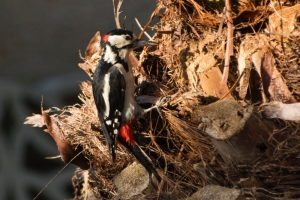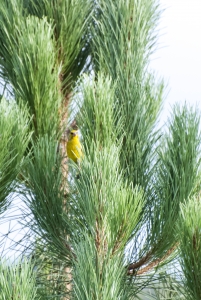A winter Tramontane might make your eyes run and your nose stream, and even freeze the oranges and lemons on your trees – but what’s not to like about snow-capped Canigou, cloudless blue skies and crystal clear views?
And even if the towns and villages go a little quiet over the winter months, there’s still loads going on in the P-O…naturally! Possibly right outside your window.
For example, if you’re woken up one morning by loud tapping in the garden, check it out. It might be a great spotted woodpecker, digging out the moth and weevil grubs that are chomping their way through your palm tree.

And if it’s too parky to venture outside to watch wildlife, it can be just as rewarding, more comfortable, and possibly safer (there are hunters about!), observing it from your living room. Put out supplementary food for the birds, and you’ll be doing them a favour and increasing your chances of seeing something fascinating. Win win situation!
The visitors you get will depend on where you live and what you offer them. If the menu du jour is always bread, you’ll attract nothing but pigeons – and the wrath of your neighbours. Bread isn’t that nutritious either.

The cute small birds you want to bring to your garden need energy from the oils in seeds and nuts, and from hard, raw fats like lard. Seed mixes and fat balls are great.
Believe it or not, there are quite a few health and safety issues surrounding what and how to feed birds. You want to nourish, not poison or injure. There’s no room to list everything here, but rspb.org has all the dos and don’ts.
Be patient, and the little chaps will come. You’re likely to get goldfinches, chaffinches and greenfinches. One winter’s day a hawfinch flew through my garden. Impressive – big, with a heavy bill and blue flash on the wing – they’re elusive but might come to a feeder or table.
Blue tits are a dead cert, along with their sturdier, more aggressive cousins, great tits. If pine trees are nearby, look out for crested tits too.

If you live close to a wood, expect nuthatches. The black stripe through their eyes makes them look like masked villains; and their behaviour confirms it! After friends installed a seed dispenser on their balcony, delight turned to dismay when a pair of nuthatches staged a daily raid, emptying the dispenser and tossing sunflower seeds everywhere. Outraged to not find peanuts maybe? Should’ve gone to Pecksavers.

On a walk recently, I was curious to see what was hammering on a cork oak. Expecting a woodpecker, I discovered a nuthatch bashing an acorn he’d wedged in a crack in the bark. The acorn kept coming away, stuck on his beak, and he had to ram it back in the crack to free himself, before viciously stabbing once more. Ha! So that’s how they got their name!
Bored with nuts and seeds? Try dried mealworms. Yum! Wrens and white wagtails love ’em. Robins and black redstarts might tuck into these as well.
And if, one cold winter’s night, you fancy trying to attract something furry, you could always spread jam on your terrace or rockery. Settle down in your dressing gown, slippers and night vision goggles, stay still and quiet…..and wait for the sweet-toothed stone marten. Don’t over-encourage though, or these cheeky rascals could move into your attic!
So, as you can see, there’s plenty going on, and we’re looking forward to sharing more of our experiences with you. Spring next – and is that an exciting time of year in the P-O or what?
CHECK OUT….
www.rspb.org for important advice on feeding birds.
DID YOU KNOW?
♥ The nuthatch (sittelle torchepot) is the only bird that climbs head-down a tree as well as head-up!
♥ The bearded vulture (gypaete barbu) lays eggs between December and February. Brrr!
♥ Some butterflies hibernate!
WHAT’S ABOUT?
♥ Buzzard (buse variable) – more numerous on the Roussillon plain in winter
♥ Black woodpecker (pic noir) in the Albères – listen for their peculiar “squeaky wheel” call
♥ Gannet (Fou de Bassan) – watch for groups just off-shore, diving for fish



